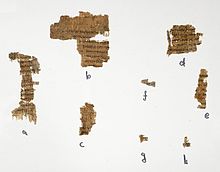Rylands Papyrus 458
The Papyrus Rylands 458 (No. 957 according to Rahlfs ) are fragments of a papyrus roll , which contains parts from the 5th book of Moses , chapters 23 to 28, in Greek . The role dates from the 2nd century BC. BC and is therefore considered to be the oldest preserved Greek translation of the Torah .
Eight small fragments have been preserved, which are continuously described in Uncials without interruption at the end of a word, there are spaces only at the end of units of meaning, dots at each end.
Tetragrammaton
The manuscript has been used in discussions of the Tetragrammaton , especially since there are spaces in places where some scholars like CH Roberts believe it contained letters. According to Paul E. Kahle , the Tetragrammaton was written in the places in the manuscript where these pauses or blanks appear and were then removed. The historian Françoise Dunand says that "as in Papyrus Fouad 266 , P. Rylands 458 of Deuteronomy, the Tetragrammaton was probably written either in square Hebrew or in archaic symbols ...". Another possibility is that the primary scribe left spaces for another to fill in later, as in Papyrus Oxyrhynchus 656 ; Martin Rösel states that "we find a gap here in Deut. 26.18, where one would expect either κύριος or the Tetragrammaton. This gap is large enough to accommodate both words, and it is likely that the writer of the Greek text denotes the Left space for someone else to insert the Hebrew characters of the Tetragrammaton.
Current location
The manuscript was possibly made in al-Fayyūm (Crocodilopolis) in Egypt. The fragments were acquired by J. Rendel Harris in 1917 and are now in the John Rylands Library in Manchester , call number Ms. Gr. P. 458.
Edition
- Colin H. Roberts: Two biblical Papyri in the John Rylands Library Manchester. Manchester 1936.
literature
- Kurt Aland : Repertory of the Greek Christian Papyri I. Biblical Papyri: Old Testament, New Testament, Varia, Apocrypha (= Patristic Texts and Studies 18). Walter de Gruyter, Berlin / New York 1975, p. 96 (No. AT 28). ISBN 3-11-004674-1
- Alfred Rahlfs , Detlef Fraenkel: Directory of the Greek manuscripts of the Old Testament: The tradition up to the 8th century (= Septuagint. Vetus Testamentum Graecum. Supplementum I, 1 ). Vandenhoeck & Ruprecht, Göttingen 2004, ISBN 3-525-53447-7 , pp. 241-242.
- Hans-Georg Opitz , Hans Heinrich Schaeder : On the Septuaginta Papyrus Rylands Greek 458. In: Journal for New Testament Science 35, 1936, pp. 115–117.
- Ernst Würthwein : The text of the Old Testament. German Bible Society, Stuttgart 1988, p. 190.
Individual evidence
- ^ Sidney Jellicoe: The Septuagint and Modern Study . Eisenbrauns, 1968, ISBN 0-931464-00-5 , pp. 271-2.
- ^ Paul E. Kahle: The Cairo Geniza . Basil Blackwell, Oxford 1959, ISBN 0758162456 , p. 222.
- ^ Françoise Dunand: Papyrus grecs bibliques (Papyrus F. inv. 266): volumes de la Genèse et du Deutéronome: introduction. In: Le Carie, Impr. De l'Institut français d'archéologie orientale. Publications de l'Institut français d'archéologie orientale du Caire .; Recherches d'archéologie, de philologie et d'histoire, t. 27. (Ed.): JSCS. 45, 1966.
- ↑ a b Martin Rösel: The Reading and Translation of the Divine Name in the Masoretic Tradition and the Greek Pentateuch - with an Appendix: Frank Shaw's Book on IAΩ . In: Tradition and Innovation: English and German Studies on the Septuagint . SBL Press, 2018, ISBN 978-0-88414-324-6 , pp. 295 ( limited preview in Google Book search).
Web links
- Ryland's Papyri on katapi.org
